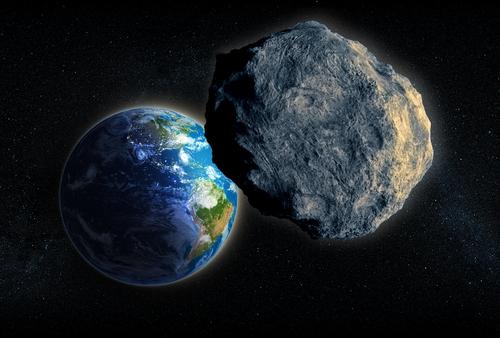A whole lot of space rock is floating around out there, and some massive asteroids have come pretty close to Earth.
On Jan. 13, 2004, for example, some scientists thought an asteroid about 100 feet wide might crash into the Earth within 36 hours. Luckily, they were mistaken, and the asteroid passed at a safe distance of more than 7 million miles (approximately 32 times the distance between Earth and the moon). As it turns out, the asteroid was also much larger than anticipated, measuring some 1,600 feet across. That’s about the size of 4.5 football fields.
In February, another large asteroid passed so close to Earth it was closer than the moon and as close as some geosynchronous satellites.
NASA states on its website: “No one should be overly concerned about an Earth impact of an asteroid or comet. The threat to any one person from auto accidents, disease, other natural disasters and a variety of other problems is much higher than the threat from NEOs [near earth objects]. Over long periods of time, however, the chances of the Earth being impacted are not negligible so that some form of NEO insurance is warranted.”
About every 10,000 years, asteroids larger than 300 feet could hit the Earth, according to NASA, causing tidal waves and local disasters. Every several hundred thousand years, asteroids about a half-mile wide could cause great global disasters, spreading debris that could partially block sunlight, cause severe acid rain, and fire storms.
Here’s a look at five asteroids that have, or may in the future, come close to Earth.
1. 2012 DA14
Size: 164 feet, 50 meters
How close: Inside the orbit of the moon
When: Feb. 15, 2013
The asteroid named 2012 DA14 (asteroids are named for the year they are first discovered) passed so close to the Earth on Feb. 15, it was not only inside the orbit of the moon, but also inside the orbit of geosynchronous satellites. The NASA website describes the impact it could have had if it hit Earth: “It could have devastated a city-sized landscape, or struck an ocean and raised dangerous tsunamis.”
2. Asteroid That Hit Chelyabinsk, Russia
Size: 55–65 feet, 17–20 meters
How close: Made impact
When: Feb. 15, 2013
Also on Feb. 15, an asteroid unrelated to the 2012 DA14 penetrated the Earth’s atmosphere and broke up, with parts of it hitting Chelyabinsk, Russia. It injured more than 1,000 people and caused millions of dollars in damage. It gave scientists a chance to study the phenomenon, and research cited by the journal Nature shows an event of a similar size may be expected about every 25 years.

The sky over Chelyabinsk, Russia, on Feb. 15, 2013. (Screenshot/NASA/YouTube)
3. 2004 AS1
Size: 1,600 feet, 500 meters
How close: 7.4 million miles, 12 million kilometers, though it was thought to be on course directly for Earth
When: January 2004
On Jan. 13, 2004, astronomers considered what kind of alarm to raise after some predicted a large asteroid might hit Earth within 36 hours. They were wary of causing undue panic, and the channels for communicating the information to authorities were also unclear. A BBC article from the time notes that procedures for raising an alarm in such a situation were reviewed following this incident.
Among various predictions for the course the asteroid was to move along, many took it safely past Earth with room to spare, but the possibility of collision had some scientists worried.
It turned out the asteroid stayed 7.4 million miles away. Alan Harris of the Space Science Institute told Universe Today that asteroids of this size and at this distance are “a dime a dozen.”
He used an analogy to highlight the difficulty of accurately gauging the course and size asteroids near Earth: “It’s rather like noticing something in the sky out of your car window that appears to be moving along with you. It could be a bird close to your car flying along at close to the same speed, or it could be a plane in the distance that only seems to be pacing your car.”
4. 2004 FH
Size: 100 feet, 30 meters
How close: 26,500 miles, or about 3.4 times Earth’s diameter
When: March 18, 2004
Every two years or so, objects about the size of the 2004 FH asteroid pass about as close to the Earth, according to NASA, but they usually pass undetected. “This particular close approach is unusual only in the sense that scientists know about it,” reported NASA at the time.
5. 2004 MN4
Size: 1,000 feet, 320 meters
How close: 1-in-60 chance it will collide with Earth
When: April 13, 2029
In 2005, Paul Chodas, Steve Chesley, and Don Yeomans at NASA’s Near Earth Object Program office calculated a 1-in-60 chance that the 2004 MN4 asteroid will hit Earth on April 13, 2029.
Chodas told NASA’s Science News the asteroid is “big enough to punch through Earth’s atmosphere,” and could cause tsunamis or devastate a region the size of Texas.
The prediction date falls on Friday 13th.

Trajectory of the 2004 MN4 asteroid. (NASA)
Researchers are developing ways to divert problem asteroids with nuclear fusion weapons. The key is to create a blast that will nudge the asteroid off a collision course with Earth without blowing it up, scattering potentially dangerous debris.
*Illustration of asteroid approaching Earth via Shutterstock






Friends Read Free